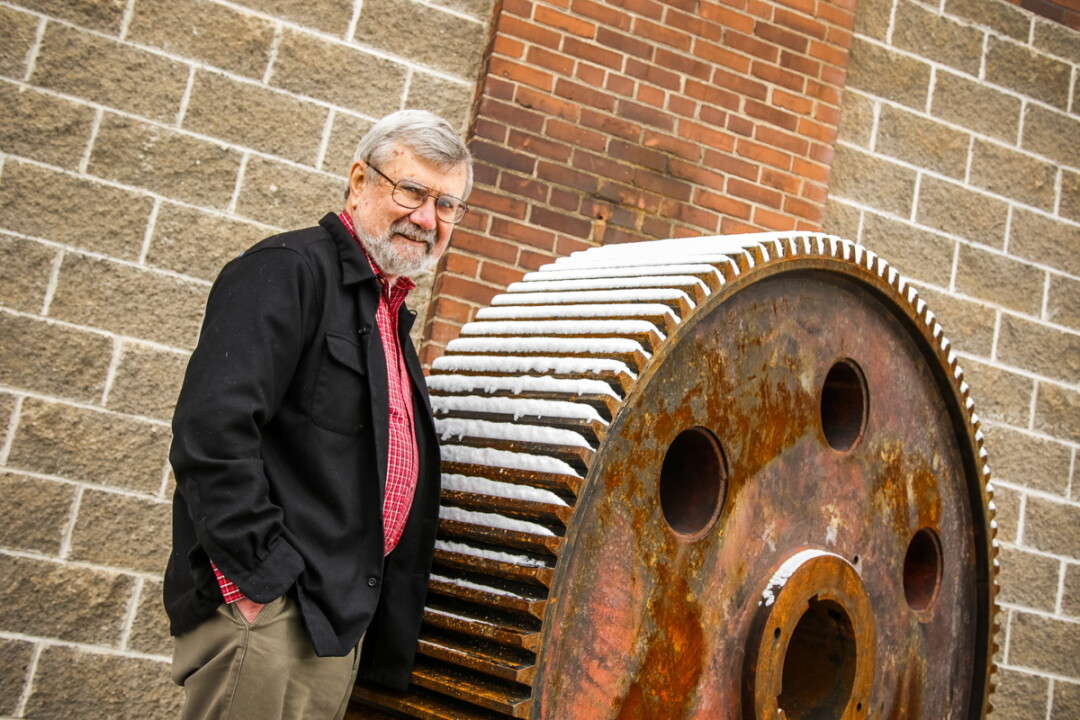Forging a City
second volume of Eau Claire history explores 20th-century industrial era
Tom Giffey, photos by Andrea Paulseth |

Over the past few years, the Confluence Project has spurred the construction of the Pablo Center and Haymarket Landing, helping add to the 21st century revitalization of downtown Eau Claire. However, as Brian Blakeley writes in the newest installment of his ongoing history of Eau Claire, a century ago an earlier “confluence project” had pumped money, life, and energy into the same neighborhood.
While the contemporary Confluence Project is largely focused on the arts, its early 20th century predecessor was broader in scope and took place over a longer period of time, roughly 1906 to 1926, Blakeley said. It involved local tax dollars, philanthropy, and private investment that created a city auditorium, hotels, department stores, and other community assets around the confluence of the Eau Claire and Chippewa rivers in downtown Eau Claire.
This first confluence project was vital to the emergence of a modern Eau Claire after the end of the lumbering era around the turn of the 20th century, Blakeley writes in A History of Eau Claire, Wisconsin – Volume II: The Manufacturing Age. The book, recently published by the Chippewa Valley Museum, details the city’s history from 1906 to 1951. It’s an era where the story of Eau Claire is deeply impact by national and global events, including World War I, the Great Depression and subsequent New Deal, and World War II. During these decades, the roles of the state and federal governments became more important in local affairs, and the ethnic rivalries and identities that had shaped life in early Claire began to diminish, Blakeley said.
“In a way Eau Claire becomes, dare I say it, less unique than it had been earlier,” said Blakeley, although he quickly added, “It doesn’t mean it’s uninteresting.”
In fact, the period is particularly interesting to Blakeley because it intersects with his grandparents’ and parents’ era as well as his own childhood: He was born in Eau Claire, graduated from Memorial High School in 1958, and has fond childhood memories of shopping at the Farmers Store, which stood roughly where the Haymarket Landing and Haymarket Plaza are today. Just a few blocks away was the imposing brick edifice of the Municipal Auditorium, built in 1919, which stood on North Barstow Street. “That was the center of the city, as far as I remember as a kid,” he said of the 2,000-seat auditorium, which hosted everything from professional wrestling matches to political speeches to eighth-grade graduations.
During the early 20th century, the rise of new manufacturing businesses – exemplified by the Gillette Safety Tire Co. (later U.S. Rubber and then Uniroyal) and the National Pressure Cooker Co. (later National Presto) – helped Eau Claire survive the fading of the lumber era. While the log drives down the Chippewa River had ended and the sawmills had mostly closed by the early 20th century, Blakeley said the wealth that the lumber era had generated helped build new businesses and was invested in the community.
“Eau Claire produces identifiable what I call wares – things that people in fact can see,” he said. From rubber tires to pressure cookers to paper, these factories’ goods helped define the era.
Though he was born, raised, and educated in Eau Claire, Blakeley spent most of his working career teaching at Texas Tech University in Lubbock, where his speciality was British imperial history. About 20 years ago he and his wife, Mary, returned to their native Chippewa Valley for retirement, and Blakeley began to pursue more localized historical interests. This led to the publication of an award-winning volume about his own family’s history in 2015, then to the first volume of A History of Eau Claire, Wisconsin in 2017.

“Basically, what I learned was how little I knew about the city,” Blakeley said of composing the most recent volume. He faces a similar challenge in writing Volume III, which he already hard at work on. This, the final volume of the series, will cover the city’s history between the 1950s and roughly the present day, a time when Eau Claire – a lumbering town and then a manufacturing hub – had to redefine itself once again.
Both volumes of A History of Eau Claire, Wisconsin are available at The Chippewa Valley Museum in Carson Park and at The Local Store, 205 N. Dewey St., Eau Claire.


















